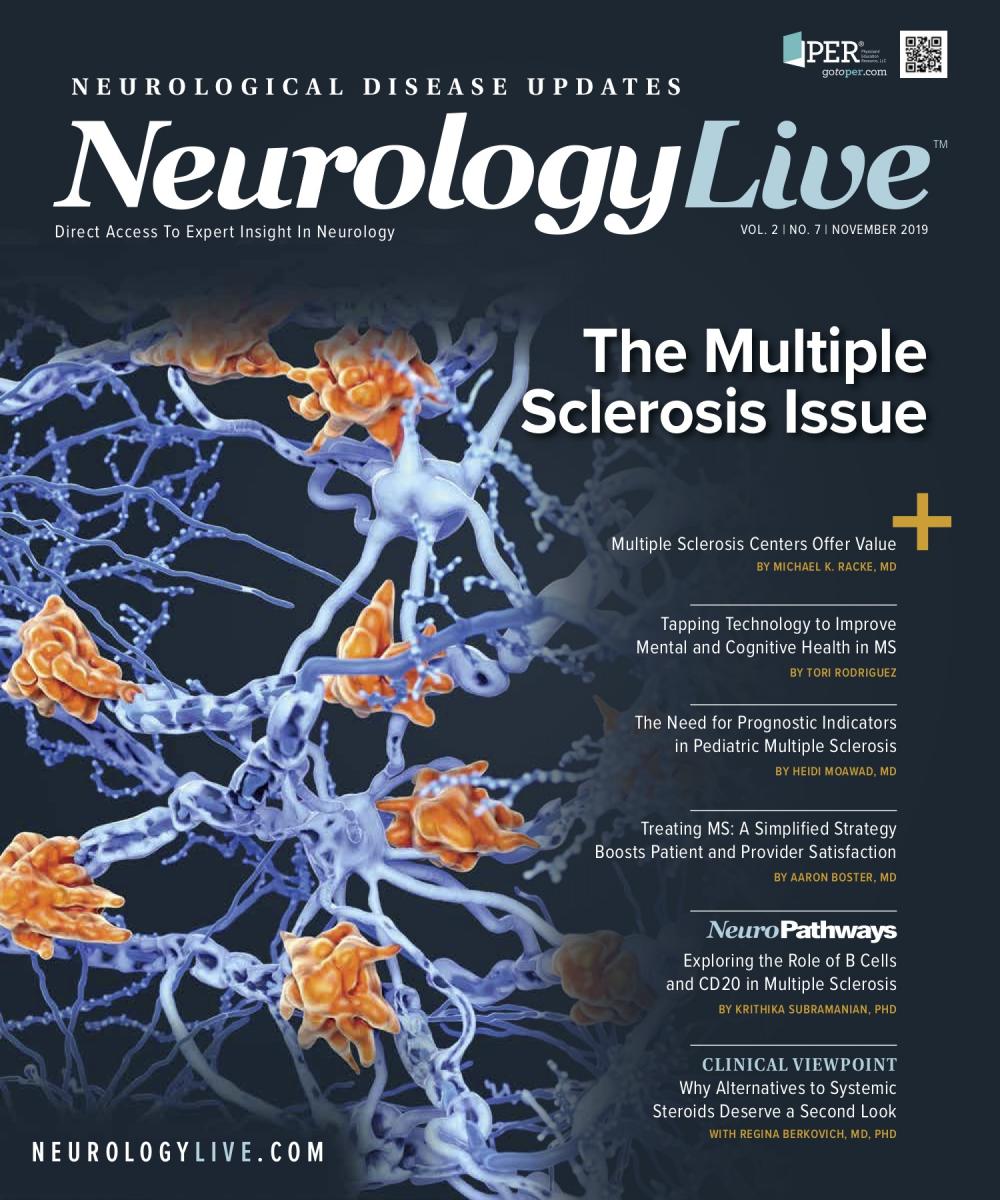Publication
Article
NeurologyLive
Multiple Sclerosis Centers Offer Value
Author(s):
The benefits of a multidisciplinary hub for disease management can mitigate the costs.

Michael K. Racke, MD
The membership of the Consortium of Multiple Sclerosis Centers (CMSC) represents a unique model of care: the team approach (FIGURE). The ability of the multiple sclerosis (MS) center to provide expert care to patients with MS continues to grow with the advent of new medications approved for the treatment of MS. Earlier this year, both siponimod (Mayzent; Novartis) and cladribine (Mavenclad; EMD Serono) were approved by the FDA for the treatment of relapsing forms of MS, including clinically isolated syndrome, relapsing-remitting MS, and active secondary progressive MS in adults.1,2 With the addition of ocrelizumab (Ocrevus; Genentech) for the treatment of primary progressive MS, the MS clinician now has tools to tackle the progressive forms of the disease, although it is likely that more work needs to be done to prevent the associated neurodegeneration.3
It is important to note that treatments for progressive forms of MS were the result of clinical trials largely performed in collaboration with MS centers that have long been the home for care of patients with more advanced disease and accumulated disability. During the past 2 decades, that model has evolved, representing the team approach to MS care along with clinical trials. It will also likely be the MS center that offers novel treatments to help stave off neurodegeneration and eventually provide the ability to reverse neurodegeneration in MS.
The neurologist’s ability to prescribe these medications highlights another growing problem in the care of MS, an issue related to the care of almost all complex medical disorders—that of cost. In addition to the steep price of medications, many other aspects of care typically delivered by the MS center also contribute to the high cost of care of these patients. This includes neuroimaging, laboratory testing, and the delivery of services such as physical, occupational, and other forms of rehabilitation that are often required by patients with MS, particularly when using a team approach. For many years, health systems tried to avoid these patients, particularly those with significant disability on government-funded insurance such as Medicare, because the reimbursement for their care did not pay well. As a result, many hospitals viewed neurologists who cared for patients with MS as an expensive luxury who would not be able to cover their salaries via the typical model of reimbursement for clinical billing.
The Value of an MS Center
Now MS centers are being recognized for their downstream revenue, particularly as it relates to a health system or academic medical center.4 The various factors that can make care of patients with MS expensive can be viewed in a positive light when one examines the various sources of revenue that also can be generated. The downstream revenue or contribution margin generated by the MS center can be quite lucrative for a health system or academic medical center, particularly one that has a specialty pharmacy and qualifies for Medicare 340B pricing, which allows the specialty pharmacy to obtain at a substantial discount the very expensive medications used in the treatment of MS. When one considers the potential profit from the specialty pharmacy, infusion services, radiological services, and laboratory services, it is not difficult to see how a health system or academic medical center can benefit greatly financially through the MS center that uses all these services in patient care. For example, 2 years ago, the financial contribution of a full-time clinical neurologist in an academic medical center was estimated to be $25 million if all therapies, imaging, and laboratory testing were obtained within that same medical center or health system.4
Addressing MS Treatment Costs
When one begins to examine the contribution of these various factors to MS care, it is clear that the proverbial gorilla in the room is the cost of treatment, particularly the infused therapies that have had a dramatic impact on reducing inflammation and disease activity in MS. Twenty-five years ago, when interferon beta-1b was approved, its annual cost was $10,900. Now the annual cost for MS therapy averages $86,000.4 MS drugs have a number of factors that contribute to this cost, including the cost of the clinical trials that resulted in the approval of these drugs and also benefited the MS centers and their patients who participated in the clinical trials. Our use of these treatments over the past 25 years has resulted in many of the gains observed in the care of patients with MS. Therefore, policies that target drug
costs in MS must not restrict access to these drugs, jeopardize the quality of these treatments, or inhibit the development of novel treatments that could result in the cure of MS.
Notably, prices of MS treatments in the United States dwarf those of medications available in other industrialized countries. However, patients living in the United States typically enjoy access to new treatments before those drugs are available to patients in other countries. Ultimately, the economics of the US pharmaceutical industry benefits patients with MS by allowing earlier access to drugs and development of innovative therapies. The same regulations that result in lower drug costs in foreign markets are also the forces that lead to reduced access to those drugs and many of the innovative treatments available to patients with MS in the United States.
Surprisingly, another area that inhibits lower drug prices in the United States is lack of competition. Patients with MS are often unaware of the actual cost of their medication. This is because insurers, the government, and employers often pay directly for medications, so the true end user—the patient—does not pay the actual cost. Patients also are often sheltered from trying to find the best price because they have insurance that minimizes out-of-pocket costs. With MS drugs in particular, rebates or other programs provided by the pharmaceutical companies often contribute to the lack of transparency in pricing.
Eliminating regulatory barriers to the supply of new drugs and generics is also needed, as it could enhance the power of competitive pricing. The examples of interferon beta and glatiramer acetate have shown that generic manufacture of these molecules has not led to the kind of price reduction that one typically sees with capsules, tablets, etc. In addition, the same medication can vary dramatically in cost depending on the pharmacy. Interestingly, the cost of the 5 most common generic medications varies by up to a factor of 20. Patients with MS need to be able to shop around for their medica- tion, but how easily that can be accomplished remains to be seen.
Another issue with transparency and prescribing of expensive medications includes pharma industry payments to prescribers, which often go unrecognized by patients. Hartung et al examined the issue of manufacturer payments to the prescribers of corticotropin, an expensive medication neurologists sometimes use to treat MS exacerbations, although neurologists were not the only type of physician studied.5 The investigators found that in a group of 235 specialists who frequently prescribed corticotropin to Medicare recipients, 207 (88%) had received a payment from the drug’s manufacturer, with over 20% receiving payments in excess of $10,000. The authors noted that payments from the drug’s manufacturer correlated with the level of prescribing. Although physicians are supposed to inform patients of these types of conflicts of interest, this is likely an area where increased transparency would be beneficial. It is also likely that similar issues exist with many of the MS medications that have a high annual cost.
The Role of MS Centers in Cost Containment
Because academic medical centers are often more expensive than community neurology practices, payers need to see evidence that the increase in cost accrued at an MS center using the team approach results in benefit to the patient and reduced costs to the payer over the long term. For example, if patients cared for at an MS center had less frequent emergency department visits and hospitalizations, this would more than make up for the increased cost of going to that center. Use of patient-reported outcome measures might also be a way in which the MS center can demonstrate high-quality care and better outcomes, which may then result in enhanced productivity and reduced disability for the patient.
The CMSC will continue to advocate for patients with MS, contribute to the development of new treatments, educate care providers, and improve a care model that provides quality care.
REFERENCES
1. Kappos L, Bar-Or A, Cree BAC, et al; EXPAND Clinical Investigators. Siponimod versus placebo in secondary progressive multiple sclerosis (EXPAND): a double-blind, randomised, phase 3 study. Lancet. 2018;391(10127):1263-1273. doi: 10.1016/S0140-6736(18)30475-6.
2. Montalban X, Leist TP, Cohen BA, et al. Cladribine tablets added to IFN-β in active relapsing MS: the ONWARD study. Neurol Neuroimmunol Neuroinflamm. 2018;5(5):e477. doi: 10.1212/NXI.0000000000000477.
3. Montalban X, Hauser SL, Kappos L, et al; ORATORIO Clinical Investigators. Ocrelizumab versus placebo in primary progressive multiple sclerosis. N Engl J Med. 2017;376(3):209-220. doi: 10.1056/NEJMoa1606468.
4. Berger JR. The financial contribution of the multiple sclerosis specialist. Neurol Clin Pract. 2017; 7(3):246-255. doi: 10.1212/CPJ.0000000000000360.
5. Hartung DM, Johnston K, Cohen DM, Nguyen T, Deodhar A, Bourdette DN. Industry payments to physician specialists who prescribe repository corticotropin. JAMA Netw Open. 2018;1(2):e180482. doi: 10.1001/jamanetworkopen.2018.0482.




